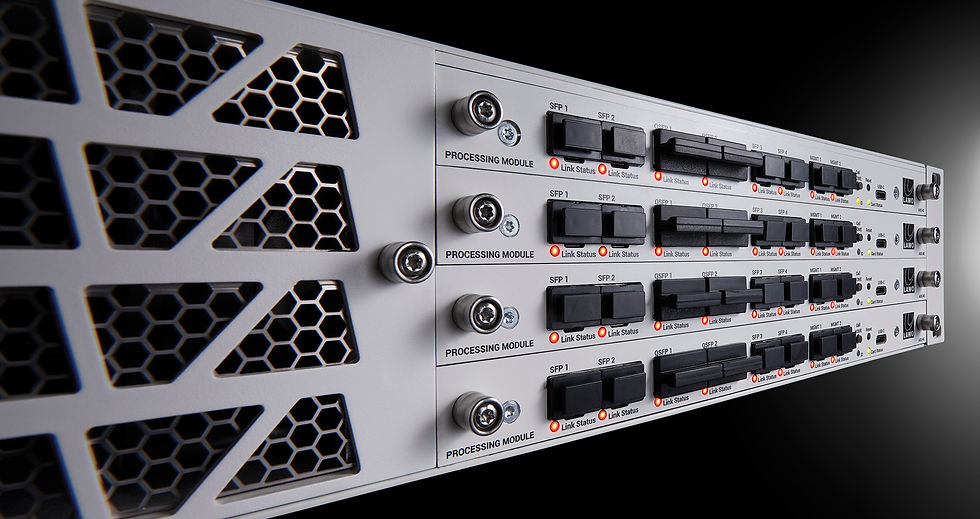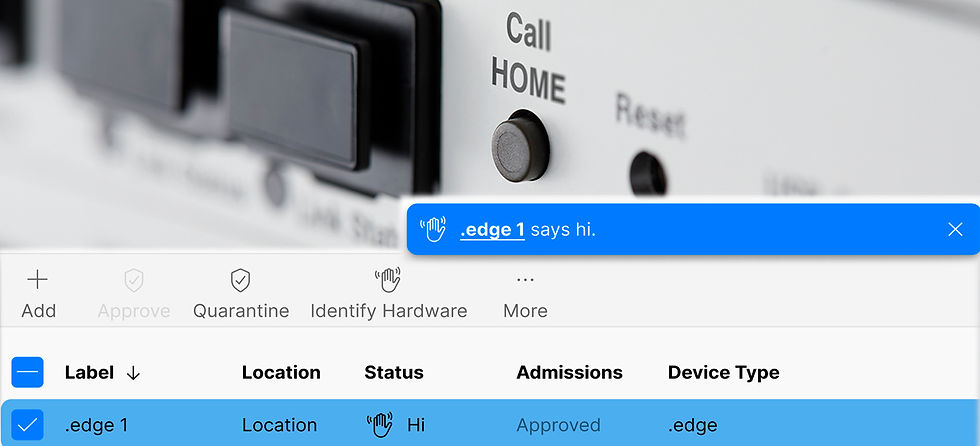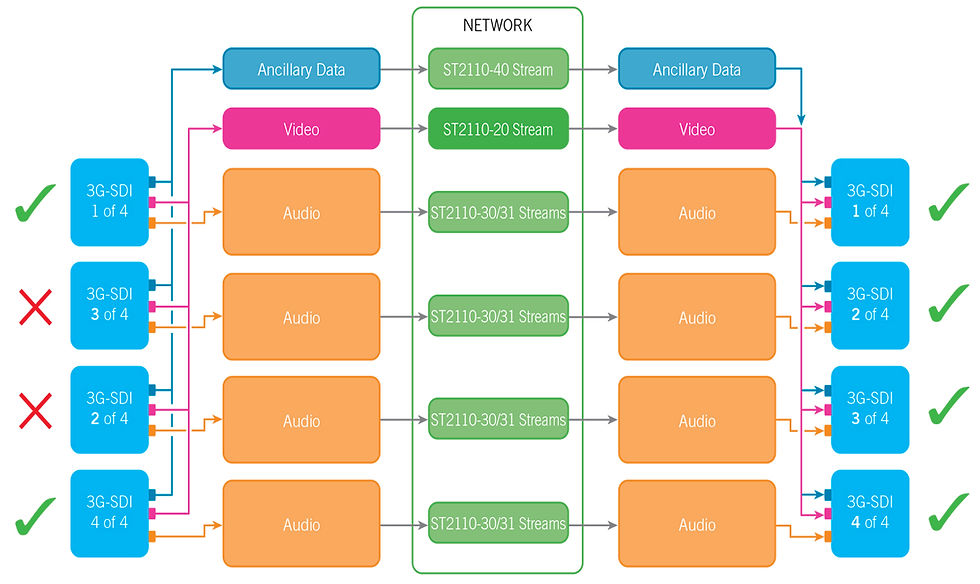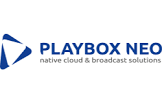.edge Hyper-Density SDI/IP Gatewayand Processing Platform
- tvtechnology
- 2025年8月25日
- 読了時間: 6分
.edge
Hyper-Density SDI/IP Gateway
and Processing Platform
REPLACE. SCALE. DISTRIBUTE.
What used to be confined to a single facility today stretches beyond the horizon: private, public and hybrid clouds as well as remote and distributed workflows are redrawing the production landscape.
The only constant in this state of flux is the need for SDI inputs and outputs in higher capacity. Lawo .edge (“dot edge”) provides this in an amazingly compact footprint, at 25GbE or 100GbE, and with all the routing capabilities users expect from Lawo.
New system software releases keep adding new and refining existing functions, while optional licenses expand .edge’s functionality right inside the unit—at the IP network’s edge—free from internal competition for compute resources.
Now also provides edge computing: see .amshuff, .colcor, .jpegxs and .proxy below. A one-of-a-kind CAPEX/OPEX solution, .edge allows you to add hardware and software functionality via software licenses—even for a limited time. Lawo FLEX subscription credits can be used to unlock optional licenses on .edge while they are not needed for HOME Apps or HOME options.
OVERVIEW
IP-native virtualized, highly modular SDI routing system
Hardware/software bundles for easy SDI router replacement
SD, HD and UHD on all inputs and outputs
High-density IP conversion, up to 192 SDI connectors per 2RU
Compact footprint, lightweight, low power requirements
HOME native, Ember+ and REST API support
Software-defined, flexibly licensable features
Powerful audio and video processing functions
HYPER DENSITY AS A SERVICE
.edge is designed with simplicity, flexibility, agility and economic efficiency in mind. Software-defined by nature, it can be used as a feature-laden replacement for traditional SDI routers, and expanded with flexible software licenses to provide the perfect mix of advanced features. With .edge, OPEX meets CAPEX in the leanest of ways.
.edge’s compact 2RU housing accommodates up to 192 HD-BNC connectors for SDI and MADI* interfacing and can be clustered to provide matrices well beyond 1152 x 1152 crosspoints. Your next large SDI router can be IP-native, 24RU small, consume only 24x 100Gbps network ports**—a third of what other offerings require—and still be more powerful, scalable and future-proof.
Support for the SMPTE ST2110 suite of standards with SMPTE ST 2022-7 redundancy is built in, providing not only advanced essence-based handling but also ensuring seamless protection switching of audio, video and ancillary data streams in both local and wide-area network operations.
Clean and quiet switching are a matter of course: devices receiving audio, video and associated metadata IP streams are accurately switched and received, typically by an ISO record channel. This makes IP workflows as transparent as SDI while remaining firmly on the IP plane.
(*) Licensable option — future product development.
(**) Calculation based on 1152 x 1152, 1080i format and non-redundant operation.
COMPONENTS
The .edge frame provides redundant power, protective housing and temperature-controlled ventilation for the processing blades and rear I/O plates. Its height of only 2RU holds up to four processing blades and four rear I/O plates, each with 48 connectors.
Thanks to its quiet operation, it can even be used in noise-sensitive places, such as control rooms, audio booths, and on-set.
.edge’s high-density processing blade is based on the latest generation of high-performance FPGAs, featuring high-bandwidth memory (HBM) for high-density, high-performance 100Gbps operation. Standard features that are added by new system releases as well as new optional licenses can be used alongside previously available .edge functionality.
.edge blades are hot-pluggable and designed to support multiple ways of connecting to the network fabric. Each blade is equipped with four 25Gbps SFP28 and two 100Gbps QSFP28 ports, each with a dedicated LINK STATUS indicator. 25GbE connectivity comes as standard, 100GbE operation can be activated via an optional license.
Device control via LAN or WAN is addressed either in-band or out-of-band via two dedicated SFP-based 1GbE management ports. Mid-plane connections inform the .edge unit about the number of processing blades that have been installed (up to four per frame), which in turn controls .edge’s automatic power regulation and temperature-controlled fan activity.
.edge’s high-density rear I/O plates are equipped with 48 HD-BNC connectors. Up to four rears can be installed in one frame for best-in-class 192 I/O capability per 2RU.
All 48 connectors provide full support for SD, HD, 3G and 12G SDI video signals and MADI audio signals*. 12 connectors are directional inputs, an additional 12 are directional outputs. The remaining 24 connectors are bi-directional and can be used either as inputs or outputs.
By design, all connectors are 12G**-capable. Quad-link 3G-SDI can be activated via an optional 3G UHD Gearboxing function when your operation migrates to UHD. The number of simultaneous 12G streams is only limited by the bandwidth on the network interfaces.
(*) Licensable option — future product development.
(**) 12G capacity usage is defined by available network capacity.
All connectors are 12G capable for future product development
(12 x 12G enabled today).
Built for Real-World Users
.edge has been designed from the ground up to be a HOME-native client. It is automatically discovered and registered within the HOME environment and benefits from all of HOME’s next-generation management features: user access control, quarantining of unknown devices, security, parameter tweaking, unlocking optional licenses via Lawo Flex, and real-time health monitoring.
HOME furthermore provides comprehensive information about the label, the video format, the audio channels, and, in case of quad-link UHD, the individual 3G legs of incoming SDI signals. Frame sync and delay settings are abstracted for intuitive control.
To expedite physical source or destination identification, each processing blade’s front panel is equipped with a CALL HOME button. Pressing it flags the processing blade within the HOME user interface for lightning-fast selection and adjustments. Conversely, operators can click a dedicated button in HOME to cause the ID indicator on a processing blade to flash, making it easy to troubleshoot cabling issues.
More Control
While HOME is the most intuitive way to control .edge, not all third-party broadcast controllers are equipped with a licensed API.
.edge therefore also fully supports the Ember+ protocol for extensive device, parameter and routing control and native support for Lawo’s VSM IP Broadcast Control System.
REST API support is available for device and parameter control using automated and scripted deployment.
‘UHD Link Rotate’ for Peace of Mind
As an industry-first, .edge offers comprehensive support for UHD scenarios with unparalleled video, audio and metadata capabilities. To assist operators of quad-link 3G-SDI cameras, replay devices, switchers, etc., in hectic situations, .edge’s unique UHD Link Rotate function automatically reshuffles the legs of a four-wire 3G-SDI link whose cables were connected in the wrong order.
By reading the 2-sample interleave signal identifiers, .edge auto-corrects the ordering before the IP stream is generated, thus ensuring that UHD signals always arrive in the expected sequential order. UHD Link Rotate is included in the optional 3G UHD Gearboxing license.
3G UHD Gearboxing
Quad-link 3G-SDI support is available through a licensable .gearbox option. Before hitting the IP data plane, quad-link 3G signals are combined into a transparent single-raster stream—to support SDQS (Square Division Quad Split), 2SI, and 4x super slow motion—rather than four separate IP streams. This significantly lowers the load on multicast addressing in the network and avoids time re-alignment issues at the destination.
The ST2110-40 ancillary data of the four 3G legs are combined on the UHD IP path, and an identifier is inserted to differentiate between the legs that supplied the ancillary packets.
On the output side, operators can choose to transmit UHD video to either one 12G or four 3G-SDI outputs. For maximum UHD signal distribution flexibility, users can repackage 12G input to quad-link 3G output, and vice versa. Single-link 12G-SDI signal input, on the other hand, requires no video gearboxing, as it is handled natively.
The .gearbox license includes the UHD Link Rotate function as well as VPID insertion on the output interface (2-sample interleave, SMPTE ST352 payload identification).
FLEXIBLE AUDIO FUNCTIONS
With a new Audio Gain function, .edge operators can adjust the levels of audio channels embedded in incoming SDI signals, either individually or in gang mode. This allows them to compensate for significant level differences between different microphone types, etc.
Up to 32 SDI inputs (@1080p) are supported, each carrying up to 32 audio signals, for a total of 1024 mono channels. Each channel has a dedicated Audio Gain control (–30dB~+18dB). The same principle applies to SDI outputs: there, changes to the gain affect the signals coming out of the standard Audio Shuffler and Embedder.
The newly-added Phase Inverter can be used to compensate for unwanted interference and artefacts caused by suboptimal microphone positioning. Phase inversion is available for both SDI inputs and outputs.
LICENSE TO THRILL
To deliver maximum OPEX flexibility for a hardware-based tool, each .edge unit can be used in a variety of scenarios simply by unlocking the required feature sets, via a flexible licensing system. This makes it easy to deploy .edge in any location—field of play, OB trucks, news gathering, control rooms, MCR, etc.—at a highly competitive price point.
In fact, .edge’s software-based specification potential is so diverse that Lawo has decided to propose a starter package that can be expanded with one or two optional licenses.
All optional licenses for .edge can be leveraged via the Lawo Flex commercial model, which offers two funding approaches: perpetual licenses and Lawo Subscriptions. For options needed on a daily basis (.framesync, for instance), consider taking out a perpetual license. Options that are only required sporadically, on the other hand, benefit from a Lawo Flex Subscription and the credits it entails. These credits can be flexibly allocated to .edge, HOME Apps and HOME functionality. Click here for details about Lawo Flex.
Given that .edge’s blade architecture is capable of delivering hyper-density edge processing, operators never need to compromise on the number of processing features they want to use simultaneously—in addition to the hyper-density gateway functionality.













コメント